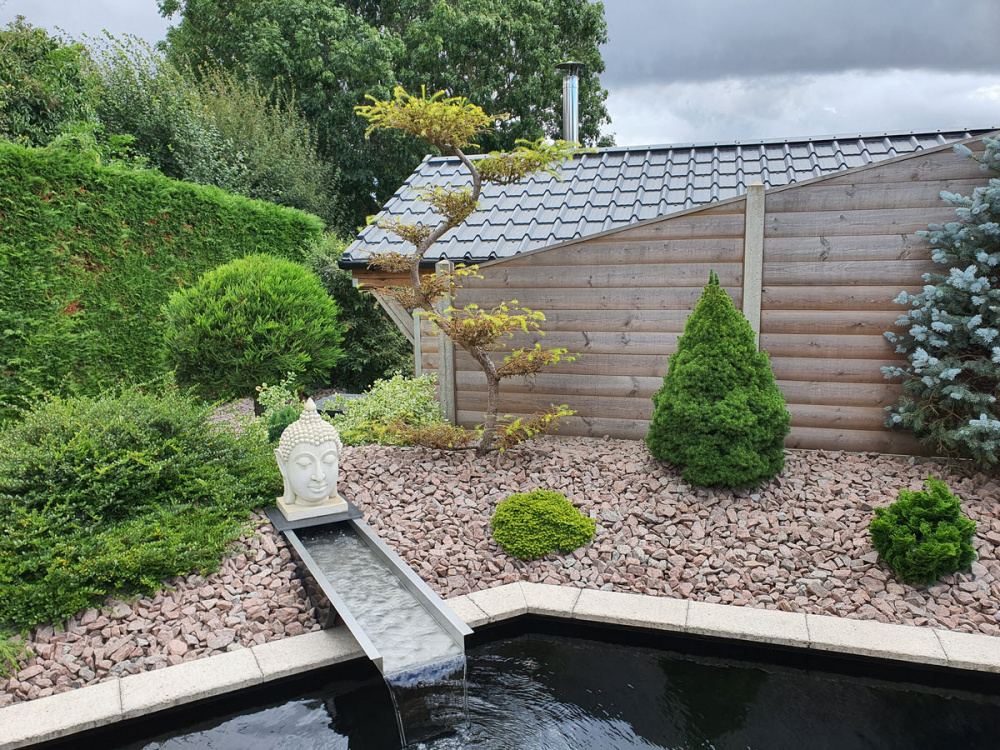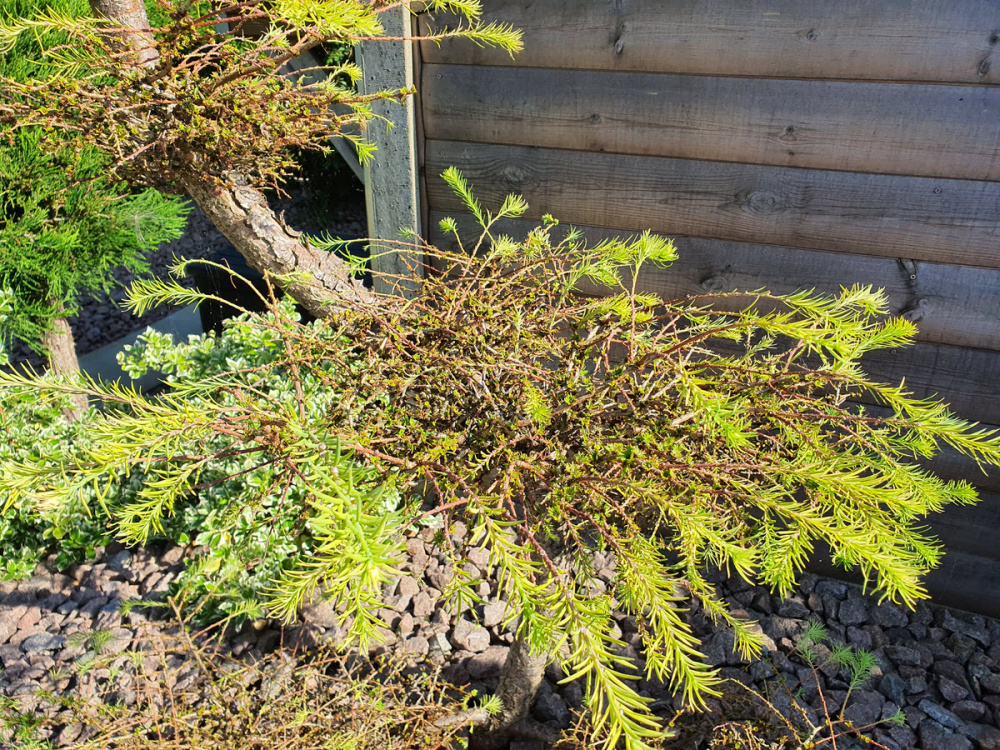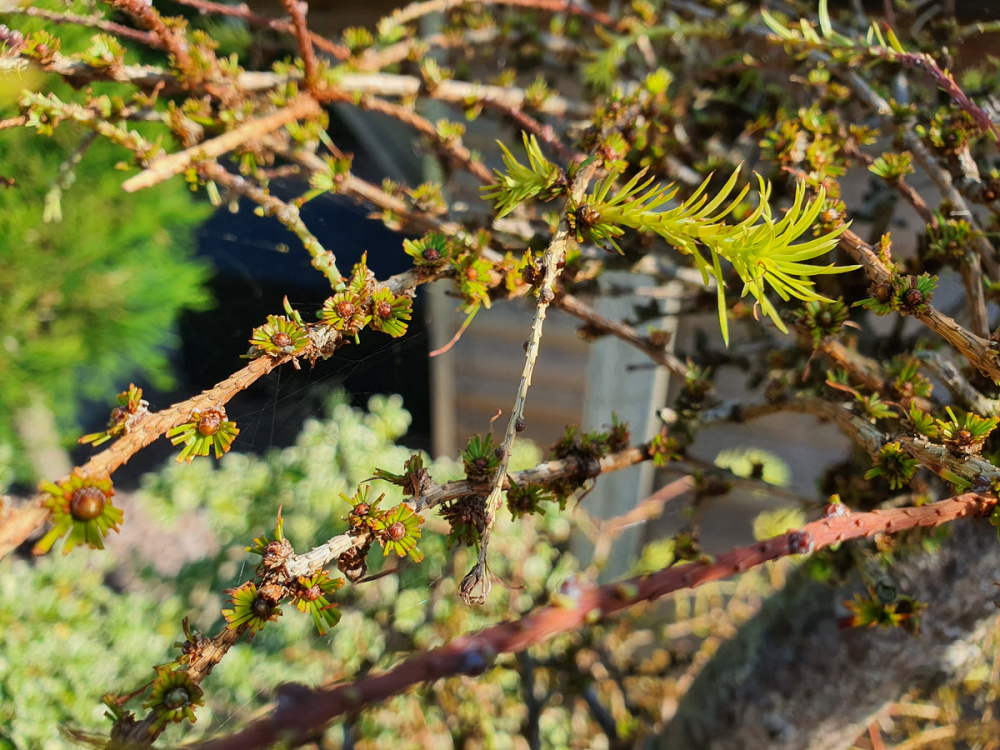This Forum will close on Wednesday 27 March, 2024. Please refer to the announcement on the Discussions page for further detail.
Larch thrives until July, then..........
Two and a half years ago my wife bought me a beautiful serpentine larch to go by our Koi pond. It was a 2m tall specimen, so the first Summer was spent applying copious amounts of water.
Last Spring the dark green needles burst forth and it was beautiful: until July.
During July it began to look worse and worse, losing most of most of the needles apart from new growth at the end of the branches and even that was pale and sickly looking. I assumed the combination of very hot and very dry Summer was the cause.

This year, the exact same symptoms. Beautiful, dark green and lush until July and then all but the "stubs" of the needles disappeared and again, yellowish new growth.
 Problem is, this year was cool and wet in July, so I think I can rule out environmental conditions (with the possible exception of lack of nutrients). Soil is not brilliant, but stays moist without getting waterlogged.
Problem is, this year was cool and wet in July, so I think I can rule out environmental conditions (with the possible exception of lack of nutrients). Soil is not brilliant, but stays moist without getting waterlogged.
I have checked online, but can't find the exact same symptoms anywhere.
Any help very gratefully received!
Please note, all pictures are from Aug 23.
PS. Spot the Sequoia!
Last Spring the dark green needles burst forth and it was beautiful: until July.
During July it began to look worse and worse, losing most of most of the needles apart from new growth at the end of the branches and even that was pale and sickly looking. I assumed the combination of very hot and very dry Summer was the cause.

This year, the exact same symptoms. Beautiful, dark green and lush until July and then all but the "stubs" of the needles disappeared and again, yellowish new growth.
 Problem is, this year was cool and wet in July, so I think I can rule out environmental conditions (with the possible exception of lack of nutrients). Soil is not brilliant, but stays moist without getting waterlogged.
Problem is, this year was cool and wet in July, so I think I can rule out environmental conditions (with the possible exception of lack of nutrients). Soil is not brilliant, but stays moist without getting waterlogged.I have checked online, but can't find the exact same symptoms anywhere.
Any help very gratefully received!

Please note, all pictures are from Aug 23.
PS. Spot the Sequoia!
0
Posts
"Have nothing in your garden that you don't know to be useful, or believe to be beautiful."
I looked at this, but close inspection several shows differences - and why is the new growth at the ends of the shoots not affected (other than being rather yellow)?
There are some new healthy "budding needle clusters" just starting again away from the branch tips as well and I don't know about the progress of this disease, but if it was exactly like this last Summer should it have looked so healthy again in April-June this year?
My logic goes like this so far:
Symptoms - Two years running, same time of year (July), one year hot and dry, one year cool and wet. Newest growth sickly, but still there.
Possible cause - some kind of pest with a life cycle making it active in July. Decimated tree and then moves to a different phase of life cycle, so newest growth not "eaten".
Just a thought.
Look hard at Pic 3, the edges od the leaves looked nibbled. Deer?
"Have nothing in your garden that you don't know to be useful, or believe to be beautiful."
Those older needles do look nibbled. Did the damage happen overnight? Does it extend to the very top of the tree (which might be above the reach of a deer, perhaps)? Have you heard of, or seen, deer in your neighbourhood?
I think you should keep a very close eye on your tree next spring. I don't know of any pest like a bug or caterpillar which would enjoy a feast of young larch needles, but you never know - and you'd need to catch it in the act to be sure.
Whether you have another problem alongside that fact I don't know. Other than a few in the woods near us also go yellow and drop all the needles soon, coming into autumn.
Edited to add. They do seem to have their very own sawfly, which may account for the chewed needles. If they are anything like the ones we get on roses and polygonatum, they can decimate the leaves quite quickly if you do not notice them.
Definitely not deer in our urban garden which is only accessible by cats it seems. Also the "nibbled" "florets" in the photos are 1cm in diameter or less and the problem is present uniformly on every part of every branch (apart from the ends) right to the top of this 2m tree.
I'm leaning towards some form of bug as mentioned.
A good dose of nuclear pesticide next June is on the cards (on a still day to avoid it getting in pond).
Water is a puzzle - dry and hot in June and tree looked great. Wet and cool in July and it looks poorly. No harm in giving more water and a feed though, so will do that.